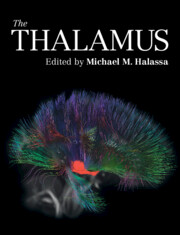Book contents
- The Thalamus
- The Thalamus
- Copyright page
- Contents
- Contributors
- Preface
- Section 1: History
- Section 2: Anatomy
- Section 3: Evolution
- Section 4: Development
- Section 5: Sensory Processing
- Section 6: Motor Control
- Section 7: Cognition
- Section 8: Arousal
- Section 9: Computation
- Chapter 21 A Dynamical Systems Perspective on Thalamic Circuit Function
- Chapter 22 Computational Contributions of the Thalamus to Learning and Memory
- Index
- References
Chapter 21 - A Dynamical Systems Perspective on Thalamic Circuit Function
from Section 9: - Computation
Published online by Cambridge University Press: 12 August 2022
- The Thalamus
- The Thalamus
- Copyright page
- Contents
- Contributors
- Preface
- Section 1: History
- Section 2: Anatomy
- Section 3: Evolution
- Section 4: Development
- Section 5: Sensory Processing
- Section 6: Motor Control
- Section 7: Cognition
- Section 8: Arousal
- Section 9: Computation
- Chapter 21 A Dynamical Systems Perspective on Thalamic Circuit Function
- Chapter 22 Computational Contributions of the Thalamus to Learning and Memory
- Index
- References
Summary
This chapter applies a perspective from biophysically grounded computational modeling to explore how the intrinsic properties of thalamic microcircuits support the computational roles that the thalamus plays in perceptual and cognitive functions. A key focus is on the modeling of neurophysiological activity in the thalamus as nonlinear dynamical systems. Dynamical modeling can give insight into thalamic function across levels of analysis, including cellular channel properties, synaptic plasticity, and anatomical connectivity. This chapter reviews how the interplay between cellular and circuit mechanisms supports thalamic contributions to neural oscillations, regulation of brain state, top-down attentional control of sensory processing, and other cognitive functions. Understanding circuit function through biophysically grounded computational modeling and dynamical systems perspectives can also provide insight into how cellular and synaptic alterations caused by pharmacology or disease can impair thalamic function.
Keywords
Information
- Type
- Chapter
- Information
- The Thalamus , pp. 401 - 415Publisher: Cambridge University PressPrint publication year: 2022
